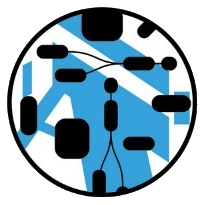Analysis, Visualization & Generation
This practice explains how to use Nasdanika products (specifically models) and related products.
The above diagram shows the core idea - load input data into a model, modify the model or create a new model from it, and save the models to native (raw) formats. Loading to a model as opposed to working with raw formats gives the following benefits:
- Unified API
- Generated model documentation with visualizations
- Different models may extend classes from core models and be treated similarly
- Model classes may be subclassed and mixed
- Cross-reference model elements
- URI handlers allows to load models from diverse sources
- On-demand loading of resources and features of model elements
- Conversion of models to graphs and making them executable with graph processors
E.g. want to read/write Excel files - take a look at the Excel metamodel and then use Ecore API to work with the model. Now want to work with PDF? A different metamodel, the same model API.
You have Java sources stored in GitLab and want model elements to reflect both Java and GitLab natures of your sources? Create a GitLabRepositoryCompilationUnit class which extends both Compilation Unit and Repository File. Customize Loader to create this class for repository files with java extension.
Want to load a PDF file directly from GitLab without having to clone the entire repository? Use GitLabURIHandler!
The below diagram illustrates the above concepts:
Models can be visualized using:
- ECharts using the ECharts model, ECharts-Java or by directly generating JavaScript/JSON. Example.
- PlantUML using DiagramGenerator, the diagram module or by directly generating PlantUML text and calling Plant UML API’s. Example.
Holistic model of an organization
One use case for the modeling approach outlined above is creation of a holistic model of an organization/corporation as exemplified by the below diagram1
In a corporation different elements of the model are typically stored in different systems and documents like Excel spreadsheets. The modeling approach allows to load those elements in a single resource set and cross-reference them. Elements which are not stored in structured formats can be captured by modeling them in diagrams and mapping those diagrams to models, see Beyond Diagrams.
One important reason why a holistic model might be beneficial for an organization is the ability of using it for AI insights. For example, using RAG/Chat on top of the organization model. Such chat can be made context-aware, chatting with the Operations will return result relevant to operations.
The above diagram is very simple, a large organization may have many layers, thousands of applications, millions of lines of code.
A model for such an organization would take some time to build, but it can be built incrementally - department by department, application by application. The value of building such a model will grow exponentially as more and more elements are added due to the network effect.
While the resulting model might be “large”, … define large. Experiments show that a model element in a model like the above takes ~ 500 bytes of RAM. As such, 1 GB of RAM would hold about 2 million model elements. Also, model resources are loaded on demand, so only the model elements needed by some task would be loaded to complete that task. With DynamicDelegate it is possible to have model elements loading their data from multiple sources on demand.
The organization model can be built on top of existing “generic” models such as Java, Maven, GitLab, Azure, …
 Nasdanika
Nasdanika